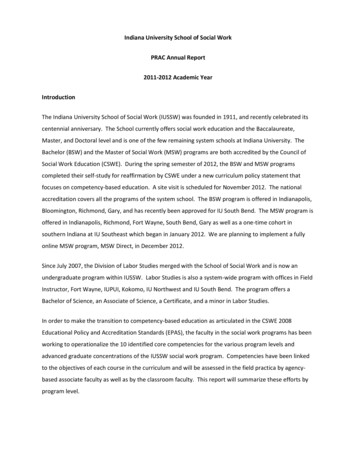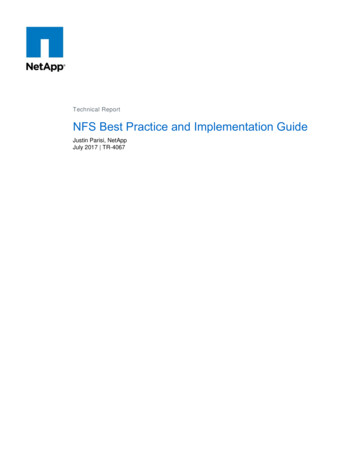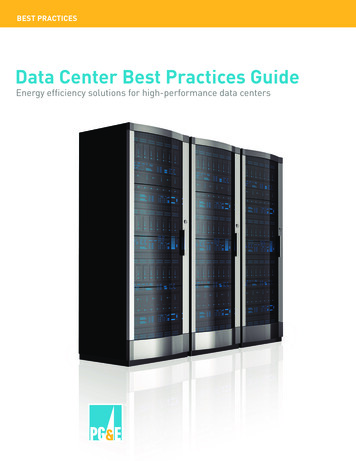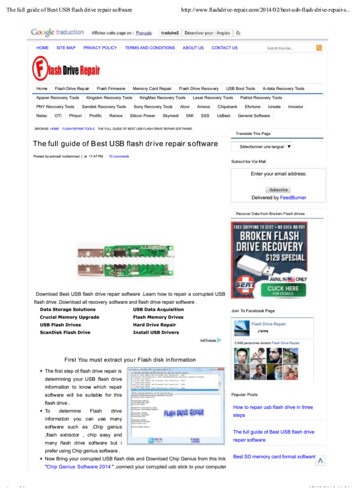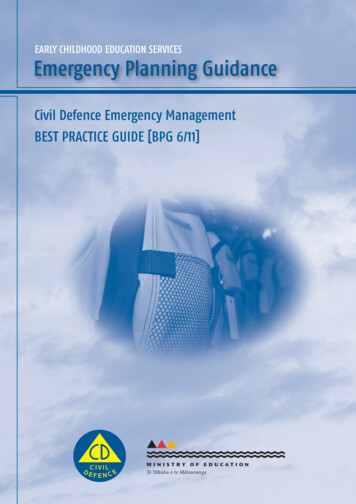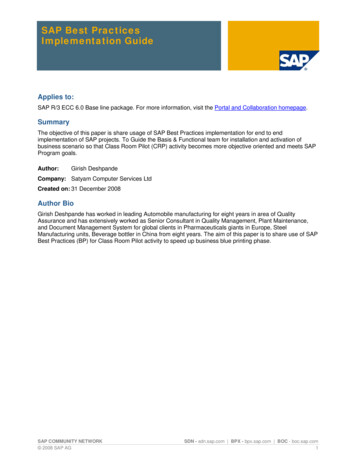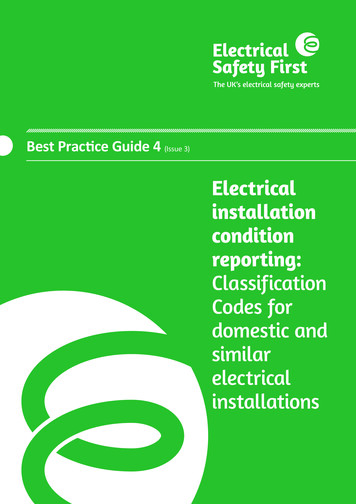
Transcription
Best Prac ce Guide 4 (Issue icationCodes fordomestic andsimilarelectricalinstallations
This is one of a series of Best Practice Guides produced byElectrical Safety First1 in association with leading industrybodies for the benefit of electrical contractors and installers,and their customers.Electrical Safety First is indebted to the following organisationsfor their contribution and/or support to the development ofthis Guide:British Gaswww.britishgas.co.ukBSI Product Serviceswww.bsigroup.comCity & ical Contractors’ itution of Engineeringand Technologywww.theiet.orgNAPITwww.napit.org.ukIn electronic format, this Guide is intended to be made available free ofcharge to all interested parties. Further copies may be downloaded fromthe websites of some of the contributing organisations.The version of this Guide on the Electrical Safety First website(www.electricalsafetyfirst.org.uk) will always be the latest. Feedback onany of the Best Practice Guides is always welcome – emailbpg@electricalsafetyfirst.org.ukElectrical Safety First is supported by all sectors of the electrical industry,approvals and research bodies, consumer interest organisations, theelectrical distribution industry, professional institutes and institutions,regulatory bodies, trade and industry associations and federations, tradeunions, and local and central government.*Electrical Safety First (formerly the National Inspection Council forElectrical Installation Contracting) is a charitable non-profit makingorganisation set up in 1956 to protect users of electricity against thehazards of unsafe and unsound electrical rgSELECT(Electrical Contractors’ Association of Scotland)www.select.org.ukSeveral of the photographs in this Guide have been extracted from a supersededElectrical Safety First DVD, courtesy of Navigator Productions Ltd. Others were kindlysupplied by Nick Blakeley Electrical and Bradford Metropolitan District Council.In electronic format, this Guide is intended to be made availablefree of charge to all interested parties. Further copies may bedownloaded from the websites of some of the contributingorganisations.The version of this Guide on the Electrical Safety First website(www.electricalsafetyfirst.org.uk) will always be the latest. Feedbackon any of the Best Practice Guides is always welcome – d by:Electrical Safety FirstUnit 331Metal Box Factory30 Great Guildford StreetLondon SE1 0HSTel: 0203 463 5100Email: bpg@electricalsafetyfirst.org.ukWebsite: www.electricalsafetyfirst.org.ukElectrical Safety First and other contributors believe that the guidanceand information contained in this Best Practice Guide is correct, but allparties must rely on their own skill and judgement when making use ofit. Neither Electrical Safety First nor any contributor assumes any liabilityto anyone for any loss or damage caused by any error or omission in thisGuide, whether such error or omission is the result of negligence or anyother cause. Where reference is made to legislation, it is not to beconsidered as legal advice. Any and all such liability is disclaimed. Electrical Safety Council. March 2014
Electrical installationcondition reporting:Classification Codes for domesticand similar electrical installationsThe aim of this Guide is to provide practical guidance for competent personson the use of the Classification Codes that need to be attributed to eachobservation recorded during the periodic inspection and testing of anelectrical installation for the benefit of the person ordering the report.The guidance is limited to the range of observations that are likely to beassociated with domestic and similar electrical installations. It takes intoaccount the publication of Amendment 1 to BS 7671: 2008.IntroductionEvery electrical installation deteriorates with useand time. Therefore, if the safety of the users is notto be put at risk, it is important that everyinstallation is periodically inspected and tested by acompetent person. Indeed, it is recommended inBS 7671: 2008 as amended (Regulation 135.1)that every electrical installation is subjected toperiodic inspection and testing.Inspecting a socket-outlet The Electrical Safety CouncilThe inspection and testing should be carried out atappropriate intervals in order to determine what, ifanything, needs to be done to maintain theinstallation in a safe and serviceable condition.The results of the inspection and testing need to beclearly detailed in a report. Any observed damage,deterioration, defects, dangerous conditions andnon-compliances with the requirements of thecurrent edition of BS 7671 that may give rise todanger should be recorded and appropriatelyclassified for remedial action.It should be borne in mind that, as stated in theintroduction to BS 7671, existing installations thathave been constructed in accordance with earliereditions of the Standard may not comply with thecurrent edition in every respect, but this does notnecessarily mean that they are unsafe for continueduse or require upgrading.page 3
An electrical installation condition report is, as its titleindicates, a report and not a certificate. It providesan assessment of the in-service condition of anelectrical installation against the requirements of theedition of BS 7671 current at the time of theinspection, irrespective of the age of the installation.The report is primarily for the benefit of the personordering the work and of persons subsequentlyinvolved in additional or remedial work, or furtherinspections. The report may be required for one ormore of a variety of reasons, each of which mayimpose particular requirements or limitations on theinspection and testing.The report is required to include details of the extentof the installation and of any limitations of theinspection and testing, including the reasons for anysuch limitations and the name of the person withwhom those limitations were agreed. It should benoted that the greater the limitations applying, thelesser is the scope of the inspection and testingcarried out, and hence the value of the report iscorrespondingly diminished. The report is alsorequired to include a record of the inspection andthe results of testing.Purpose of periodic inspection,testing and reportingThe main purpose of periodic inspection and testingis to detect so far as is reasonably practicable, and toreport on, any factors impairing or likely to impairthe safety of an electrical installation.The aspects to be covered include all of thefollowing: Safety of persons against the effects of electricshock and burns Protection against damage to property by fireand heat arising from an installation defect Confirmation that the installation is notdamaged or deteriorated so as to impair safety Identification of non-compliances with thecurrent edition of BS 7671, or installationdefects, which may give rise to danger.The report provides a formal declaration that, withinthe agreed and stated limitations, the detailsrecorded, including the observations andrecommendations, and the completed schedules ofinspection and test results, give an accurateassessment of the condition of the electricalinstallation at the time it was inspected.Electrical installations in poor condition present risks of fire aswell as electric shockA typical periodic inspection notice for an older installationpage 4 The Electrical Safety Council
The inspectorAll persons carrying out the inspection and testing ofelectrical installations must be competent to do so.If the inspector is competent and takes all thenecessary safety precautions including following thecorrect procedures, the process of inspecting andtesting should not create danger to persons, or causedamage to property.Past events indicate that persons undertakingelectrical installation condition reporting need tohave extensive knowledge and experience ofelectrical installation matters to enable them tosafely and accurately assess the condition of anexisting electrical installation. This is especially sowhen they do not have access to the design ormaintenance information relating to thatinstallation.A continuity test being carried outTo be competent to undertake the periodicinspection and testing of an existing electricalinstallation, persons must as a minimum: Have sufficient knowledge and experience ofelectrical installation matters to avoid injury tothemselves and others Be familiar with, and understand, therequirements of the current edition of BS 7671including those relating to inspection, testingand reporting Be skilled in the safe application of theappropriate test instruments and procedures Have a sound knowledge of the particular typeof installation to be inspected and tested Have sufficient information about the functionand construction of the installation to allowthem to proceed in safety. The Electrical Safety CouncilGuidance on safe isolation procedures is available inanother Best Practice Guide (No 2 in the series)published by Electrical Safety First, which can bedownloaded free of charge fromwww.electricalsafetyfirst.org.uk and othercontributing bodies.page 5
Periodic inspection andtesting proceduresThe procedures for periodic inspection and testingdiffer in some respects from those for the initialverification of new installation work. This is becausethe subject of an electrical installation conditionreport is usually an installation which has beenenergised and in use for some time. Particularattention therefore needs to be given during theinspection process to assessing the condition of theinstallation in respect of:Also, for reasons beyond the inspector’s control, theinspector may be unable to gain access to parts ofthe existing installation. For example, it is usuallyimpracticable to inspect cables that have beenconcealed within the fabric of the building. Where, during the course of inspection or testing, areal and immediate danger is found to be present inan installation (from an accessible exposed live part,for example), immediate action will be necessary tomake it safe before continuing. However, thediscovery of the dangerous condition should still berecorded in the report and classified accordingly.SafetyWear and tearCorrosionDamage and deteriorationExcessive loadingAgeExternal influencesSuitability (taking account of any changes inuse or building extensions etc).A potentially overloaded socket-outletpage 6Such restrictions are likely to result in the inspectionand testing of those parts of the installation beinglimited, or being omitted entirely from the process.Inspectors should note that, even in domesticpremises, Section 3 of the Health and Safety atWork etc Act 1974 and the Electricity at WorkRegulations 1989 effectively require them toendeavour to make safe, before leaving site and withthe agreement of the user or owner, any dangerousconditions found in an installation. For example,where there are accessible live parts due to blanksmissing from a consumer unit, suitable temporarybarriers should be provided to protect persons fromdirect contact with those live parts.As persons using the installation are at risk, it is notsufficient simply to draw attention to the dangerwhen submitting the electrical installation conditionreport. At the very least, the inspector must ensurethat the client is made aware, at the time ofdiscovery, of the danger that exists. An agreementshould be made with the client as to the appropriateaction to be taken to remove the source of danger(for example, by switching off and isolating theaffected part of the installation until remedied),before continuing with the inspection or testing. The Electrical Safety Council
A dangerous condition - line conductor connected to the metallicenclosure of a light fitting (in addition to exposed conductors)Some certification, registration and membershipbodies make available ‘dangerous conditionnotification’ forms. These assist inspectors to record,and then to communicate immediately to theperson responsible for the safety of the installation,any dangerous condition discovered. The Electrical Safety Councilpage 7
ObservationsThe periodic inspection and testing proceduresshould identify any damage, deterioration, defectsand conditions within the installation that give rise,or potentially give rise, to danger. The proceduresshould also identify any deficiencies for whichremedial action would contribute to a significantimprovement in the safety of the electricalinstallation.After due consideration, each such observed safetyissue should be recorded at the appropriate point inthe inspection or test results schedule, and furtherdetailed in the ‘observations’ section of the report.Only observations that can be supported by one ormore regulations in the edition of BS 7671 currentat the time of the periodic inspection should berecorded. The particular regulation number(s) neednot be entered in the report (unless specificallyrequired by the client), but should serve to remindthe inspector that it is only compliance with BS 7671that is to be considered. Observations based solelyon personal preference or ‘custom and practice’should not be included.The observations should be based on therequirements of the edition of BS 7671 current atthe time of the inspection, not on the requirementsof an earlier edition current at the time theinstallation was constructed.Each observation should be written in a clear,accurate and concise manner that is likely to beunderstood by the person ordering the work.Technical terms should be avoided or explainedunless it is known that the recipient is an electricalengineer or electrician, for example.An electrical installation condition report is intendedto be a factual report on the condition of aninstallation, not a proposal for remedial work.Therefore, each recorded observation shoulddescribe a specific defect, omission or item for whichimprovement is recommended.Recessed luminaire above a bath (outside the zones)The observation should detail what the situation is,and not what is considered necessary to put it right.For example, ‘excessive damage to the consumerunit enclosure’ would be appropriate, whereas‘consumer unit to be replaced’ would not.page 8 The Electrical Safety Council
Classification CodesEach observation relating to a concern about thesafety of the installation should be attributed anappropriate Classification Code selected from thestandard codes C1, C2 and C3. Each code has aparticular meaning:Code C1 ‘Danger present’. Risk of injury.Immediate remedial action required.Code C2 ‘Potentially dangerous’.Urgent remedial action requiredCode C3 ‘Improvement recommended’.Where a Classification Code C1 is consideredappropriate, the client is to be advised immediately,and also in writing, that immediate remedial actionis required (or has been taken) to remove thedanger. As previously indicated, this action isnecessary to satisfy the duties imposed on theinspector and other duty holders by the Health andSafety at Work etc Act 1974 and the Electricity atWork Regulations 1989.Wherever an item in the inspection or test resultsschedule has been attributed a Classification CodeC1, C2 or C3, there should be a correspondingobservation in the ‘observations’ section ofthe report.Only one of the standard Classification Codes shouldbe attributed to each observation. If more than oneClassification Code could be attributed to anobservation, only the most serious one should beused (Code C1 being the most serious).Where the inspection and testing proceduresidentify an item which is dangerous or potentiallydangerous, it should be identified in the inspectionor test results schedule of the report by attributing toit a Classification Code C1 or C2, as appropriate, inthe ‘outcome’ column of the inspection schedule or,where provided, the ‘remarks’ column of the testschedule.Where the inspection and testing proceduresidentify an item which is not dangerous orpotentially dangerous, but for which improvement isrecommended, it should be identified in theinspection or test results schedule of the report byattributing to it a Classification Code C3 in the‘outcome’ column of the inspection schedule or,where provided, the ‘remarks’ column of the testschedule.Live parts exposed to touchWhere during inspection and testing a real andimmediate danger is observed that puts thesafety of those using the installation at risk,Classification Code C1 (danger present) mustbe given. The Electrical Safety Councilpage 9
In general terms, theClassification Codes should beused as follows:Code C1 (Danger present)This code should be used to indicate that dangerexists, requiring immediate remedial action.Further investigationThe model forms in BS 7671: 2008 incorporatingAmendment 1 provide for a need for furtherinvestigation to be indicated against each inspectionand test outcome, and against each observation.Usually, however, it should be possible to attribute aClassification Code to each observation without theneed for further investigation.The persons using the installation are at immediaterisk. The person ordering the report should beadvised to take action without delay to remedy theobserved deficiency in the installation, or to takeother appropriate action (such as switching off andisolating the affected parts of the installation) toremove the danger. The inspector should not waitfor the full report to be issued before giving thisadvice.The purpose of periodic inspection, as previouslystated, is not to carry out a fault-finding exercise, butto assess and report on the condition of aninstallation within the agreed extent and limitationsof the inspection. Therefore, where an observationcan be attributed a Classification Code, furtherinvestigation would not be required for the purposesof completing the condition report.As previously indicated, some certification,registration and membership bodies make available‘dangerous condition notification’ forms to enableinspectors to record, and then to communicateimmediately to the person ordering the report, anydangerous condition discovered.Further investigation should not be called for inrespect of any observation unless that investigationcould reasonably be expected to reveal danger orpotential danger. Further investigation should not becalled for simply because it would be ‘nice to know’– for example, why a socket-outlet is unearthed.Code C2 (Potentially dangerous)If an observation cannot be attributed aClassification Code due to reasonable doubt asto whether danger or potential danger exists,the outcome of the assessment must bereported to be unsatisfactory.This code should be used to indicate that, whilst anobserved deficiency is not considered to bedangerous at the time of the periodic inspection, itwould become a real and immediate danger if afault or other foreseeable event was to occur in theinstallation or connected equipment.The person ordering the report should be advisedthat, whilst the safety of those using the installationmay not be at immediate risk, remedial actionshould be taken as a matter of urgency to removethe source of potential danger.The person ordering the report should be advisedthat the inspection and/or testing has revealed apotential safety issue which could not, due to theagreed extent or limitations of the inspection, befully determined, and that the issue should beinvestigated as soon as possible.An example of an observation that might possiblyjustify further investigation is given on page 17.Code C3 (Improvement recommended)This code should be used to indicate that, whilst anobserved deficiency is not considered to be a sourceof immediate or potential danger, improvementwould contribute to a significant enhancement ofthe safety of the electrical installation.page 10Departures from the requirements of the currentedition of BS 7671 that do not give rise todanger or need improvementAmendment 1 to BS 7671: 2008 no longer requiresdepartures from the requirements of the currentedition of BS 7671 that do not give rise to danger orneed improvement to be recorded in conditionreports. (Examples of such departures are given onpage 17.) The Electrical Safety Council
Summary of the conditionof the installationThe summary should adequately describe thegeneral condition of the installation in terms ofelectrical safety, taking into account the specificobservations made. It is essential to provide a clearsummary of the condition of the installation havingconsidered, for example: The adequacy of the earthing and bondingarrangements The suitability of the consumer unit and othercontrol equipment The type(s) of wiring system, and its condition The presence of adequate identification andnotices The extent of any wear and tear, damage orother deterioration Changes in use of the premises that have ledto, or might lead to, deficiencies in theinstallation.The serviceability of equipment, includingaccessoriesMinimal descriptions such as ‘poor’, andsuperficial statements such as ‘recommend arewire’, are considered unacceptable as they donot indicate the true condition of aninstallation. It will often be necessary orappropriate to explain the implications of anelectrical installation condition report in acovering letter, for the benefit of recipients whorequire additional advice and guidance abouttheir installation.For example, where an installation has deterioratedor been damaged to such an extent that its safeserviceable life can reasonably be considered to beat an end, a recommendation for renewal should bemade in a covering letter, giving adequatesupporting reasons. Reference to the covering lettershould be made in the report. The Electrical Safety CouncilUnsatisfactory connection to a downlighterOn the model electrical installation condition reportgiven in BS 7671, a box is provided for the overallassessment of the condition of the installation to begiven. After due consideration, the overall conditionof the installation should be given as either‘satisfactory’ or ‘unsatisfactory’.If any observation in the report has been givena Code C1 or Code C2 classification ascategorised in this Guide, or if any observationsrequire further investigation to determinewhether danger or potential danger exists, theoverall assessment of the condition of theinstallation must be reported to be‘unsatisfactory’.If there are no observations in the report classifiedas C1 or C2, or that require further investigation, itwould not be reasonable to report the overallcondition of the installation as unsatisfactory.The recommended interval until the nextinspection should be made conditional upon allobservations that have been given aClassification Code C1 (danger present) beingremedied immediately and all observations thathave been given a Code C2 (potentiallydangerous) or that require further investigationbeing remedied or investigated respectively as amatter of urgency.Where the space provided for the description of thegeneral condition of the installation is inadequatefor the purpose and it is necessary to continue thedescription on an additional page(s), the pagenumber(s) of the additional page(s) should berecorded.page 11
Examples of the use of Classification CodesExamples of the use ofClassification CodesIt is entirely a matter for the competent personconducting the inspection to decide on theClassification Code to be attributed to anobservation. The inspector’s own judgement asa competent person should not be undulyinfluenced by the person ordering the work. Theperson(s) signing the report are fully responsiblefor its content and accuracy. Conductive parts have become live as theresult of a fault Incorrect polarityCode C2 (Potentially dangerous)Observations that would usually warrant a Code C2classification include: Absence of a reliable and effective means ofearthing for the installationThe following examples are not exhaustive. Allreferences to RCD protection mean additionalprotection by an RCD having a rated operating(tripping) current (I n) not greater than 30 mAand an operating time not exceeding 40 ms at aresidual current of 5 I n.Code C1 (Danger present)Observations that would almost certainly warrant aCode C1 classification include: Exposed live parts that are accessible to touch,such as where: a fuse carrier or circuit-breaker is missingfrom a consumer unit and a blanking piece isnot fitted in its placeterminations or connections have no (ordamaged) barriers or enclosureslive conductors have no (or damaged)insulationAbsence of a reliable means of earthing A public utility water pipe being used as themeans of earthing for the installation A gas or oil pipe being used as the means ofearthing for the installation Cross-sectional area of the earthing conductordoes not satisfy adiabatic requirements (that is,does not comply with Regulation 543.1.1) Absence of a circuit protective conductor for alighting circuit supplying one or more items ofClass I equipment, or connected to switcheshaving metallic face plates2 Absence of a notice warning that lightingcircuits have no circuit protective conductor2 Absence of a circuit protective conductor for acircuit, other than a lighting circuit, supplyingone or more items of Class I equipment Absence of earthing at a socket-outletan accessory is badly damaged.Absence of main protective bondingSocket-outlet with broken face plate2 See the Electrical Safety First Best Practice Guide No 1 - replacing a consumer unit in domestic premises where lighting circuits haveno protective conductor.page 12 The Electrical Safety Council
Examples of the use of Classification Codes Inadequate cross-sectional area of a mainprotective bonding conductor where theconductor is less than 6 mm2 or where there isevidence of thermal damage Socket-outlets other than SELV or shaver socketoutlets located less than 3 m horizontally fromthe boundary of zone 1 in a location containinga bath or shower Absence of supplementary bonding whererequired3 , such as in a location containing abath or shower, where any of the followingthree conditions are not satisfied: Absence of fault protection (protection againstindirect contact) by RCD where required, suchas for a socket-outlet circuit in an installationforming part of a TT system Circuits with ineffective overcurrent protection(due, for example, to oversized fuse wire inrewireable fuses) All final circuits of the location comply withthe requirements of Regulation 411.3.2 forautomatic disconnection, andAll final circuits of the location haveadditional protection by means of a 30 mARCD, andAll extraneous-conductive-parts of thelocation are effectively connected to theprotective equipotential bonding (mainearthing terminal).Checking a fuse carrier (base missing) A protective device installed in a neutralconductor only Separate protective devices in line and neutralconductors (for example, double-pole fusing)Absence of supplementary bonding The main RCD or voltage-operated earthleakage circuit-breaker on a TT system fails tooperate when tested with an instrument orintegral test button Absence of RCD protection for portable ormobile equipment that may reasonably beexpected to be used outdoors Absence of RCD protection for socket-outlets ina location containing a bath or shower, otherthan for SELV or shaver socket-outletsDouble-pole switch with fuses in each pole3Where the presence of supplementary bonding cannot be confirmed by inspection, it may be verified by a continuity test ( 0.05Ω) The Electrical Safety Councilpage 13
Examples of the use of Classification Codes Earth fault loop impedance value greater thanthat required for operation of the protectivedevice within the time prescribed in the versionof BS 7671/IET Wiring Regulations current atthe time of installation A ring final circuit having a discontinuousconductor A ring final circuit cross-connected withanother circuit Inconsistent resistance values for theconductors of ring final circuits Unsatisfactory electrical connection (such asa loose connection or type, number and/orsize of conductors unsuitable for the meansof connection) Insulation of live conductors deteriorated tosuch an extent that the insulating materialreadily breaks away from the conductorsCrumbling vulcanised rubber insulation Sheath of an insulated and sheathed nonarmoured cable not taken inside the enclosureof an accessory, such as at a socket-outlet orlighting switch, where the unsheathed cores areaccessible to touch and/or likely to come intocontact with metalwork. (Note: Code C3 wouldapply if the unsheathed cores are notaccessible to touch nor likely to come intocontact with metalwork)Unsatisfactory electrical connections A ‘borrowed neutral’, for example where asingle final circuit neutral is shared by two finalcircuits (such as an upstairs lighting circuit anda separately-protected downstairs lightingcircuit)Insulation resistance of less than 1 MΩbetween live conductors connected togetherand Earth, when measured at the consumerunit with all final circuits connectedpage 14Cable sheath not taken inside metallic enclosure Unenclosed electrical connections, such as atluminaires. (Such a defect can contribute to afire, particularly where extra-low voltagefilament lamps are used) Fire risk from incorrectly installed electricalequipment, including incorrectly selected orinstalled downlighters The Electrical Safety Council
Examples of the use of Classification Codes Fire risk from lamps exceeding the maximumrated wattage for the luminaires, or placed tooclose to combustible materials Evidence of excessive heat (such as charring)from electrical equipment causing damage tothe installation or its surroundings Unsatisfactory functional operation ofequipment where this might result in danger Immersion heater doe
Every electrical installation deteriorates with use and time. Therefore, if the safety of the users is not to be put at risk, it is important that every installation is periodically inspected and tested by a competent person. Indeed, it is recommended in BS 7671: 2008 as amended (Regulation 135.1) that every
